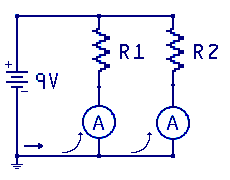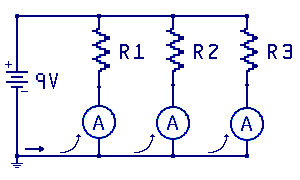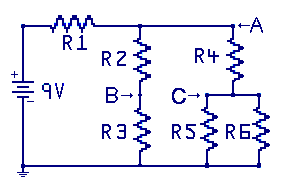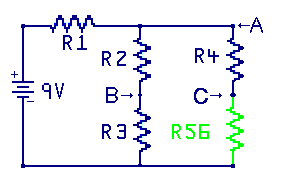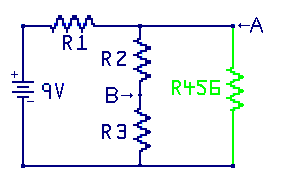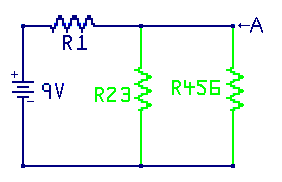Go Home
Go To Introduction
This is Book 1
Chapter 1 - Electricity
Chapter 1.2 - The Numbers
Chapter 2 - Sharing and Bonding
Chapter 3 - Voltage
Chapter 3.2 - Voltage Static
Chapter 3.3 - Batteries
Chapter 3.4 - Solar - Others
Chapter 4 - Resistance
Chapter 4.2 - Parallel Resistance
Chapter 4.3 - Voltage Dividers
Chapter 5 - Semiconductor
Chapter 5.2 - PNP NPN Junctions
Chapter 6 - Capacitor
Back To The Guide
To Book 2
Parallel Resistance
Resistors in parallel may take a few more calculations.
When there are parallel paths, some current will flow through one
path and some through another path(s). The voltage across a group
of parallel items is the same for each item. Ohms Law tells us
that for any given voltage across a circuit, or section of a
circuit, that voltage will equal the product of the circuit
current, times the circuit resistance. If the current increases,
then the resistance must decrease by some amount to keep the
product the same. So in the formula E= I x R the current is
inversely proportional to the resistance. We also know that if
there are two resistors of different values in parallel, the path
with the lower value of resistance to the current flowing will
have the more current flowing through it.
With resistors in parallel we need to calculate the circuits
equivalent resistance before we can calculate the total current
flowing through the set of resistors. There are two formulas for
finding the total resistance of parallel resistors in a circuit.
A shorthand formula for just 2 resistors in parallel and the
general formula for any number of resistors in parallel circuit.
In this circuit diagram there are two resistors labeled R1 and
R2 wired in parallel. Some of the current will flow through R1
and some other current will flow through R2. One question that
comes to mind is how much current flows through each path? The
voltage across each resistor is the same.
Given: 9 volt supply, R1 is 510 Ohms, R2 is 1000 ohms.
Find: Current flowing through the R1 path and through the R2 path?
Step 1: Find the total resistance.
SHORTHAND FORMULA: (works for just two resistors)
(R1 X R2) / (R1 + R2) The product, divided by the sum.
(510 X 1000) / (510 + 1000 ) OR (510,000/1510) OR 337 ohms
GENERAL FORMULA:
1 / ( (1/R1) + (1/R2) + and so on (1/Rx) )
Applying the general formula to this problem - R1 and R2
( 1 / ( 0.00196 + .001 ) ) OR (1/0.00296) OR 338 Ohms
NOTE: The Total resistance of resistors in parallel will always
be less than the smallest value resistor.
Step 2: Find the total current. I = E / R
I = 9(V) / 337(Ohms) = 0.0267 A, rounded to 27 ma
Step 3: Find the current through each path
Percent = Total Resistance / resistor value.
For R1 337 / 510 = 66 %
For R2 337 / 1000 = 34 %
Total current times percent of current or
.027 X .66 = rounded to 0.018A or 18 ma for R1
.027 x .34 = rounded to .009A or 9 ma for R2
Take a moment to think about these answers.
One path has twice the resistance to current flow, so it
is reasonable that it will only have half the current flow.
In this circuit diagram three resistors labeled R1, R2 and R3 wired
in parallel. In this circuit the current is split into three paths.
Given:
9 volt supply
R1 is 1000 Ohms or 1k ohm
R2 is 2700 ohms or 2.7k ohm
R3 is 3300 ohms or 3.3k ohm
Find: Current flow in each path: for R1, R2 and R3.
Step 1: Calculate the Total Resistance
General formula:
1 / ((1/R1) + (1/R2) + (1/R3))
1 / (0.001 + 0.00037 + 0.0003) OR 1/0.00167 OR 598.8 Ohms
Step 2: Calculate Total Current
General Current Formula: I = E / R
9(volts) / 600(ohms rounded off) = 15 ma
Step 3: Find the current through each path
Percent = Total Resistance / resistor value.
For R1 598 / 1000 = 60 %
For R2 598 / 2700 = 22 %
For R3 598 / 3300 = 18 %
Path current
R1 0.015 x .60 = 9 ma
R2 0.015 x .22 = 3.3 ma
R3 0.015 x .18 = 2.7 ma
Check the work we just did:
R1 is the lease resistance and the most current.
R2 and R3 currents seem reasonable.
Combination Circuits
Resistors in combination circuits take more time but are not all that
hard to calculate. Bringing series and parallel circuits all together
they function as one combination circuit. The process is to simplify
and redrawn, over and over until it is solved.
Given: 9 volt supply, All 6 Resistors are 1000 Ohms
Find: Voltages at test points A, B and C with respect to ground.
NOTE: With the voltage and all resistor values given, the total
R-equivalent can be calculated. With those totals the
total current can be calculated.
Here are the steps.
Step 1:
Solve the parallel set R5 and R6
Work: R56 = (1000x1000) / (1000 + 1000) = 500 Ohms
R-equivalent R56 = 500 Ohms
After redrawing the circuit with the new R56
resistor in place, it should look like this.
Step 2:
Solve the series set R4 and R56
Work R456 = 1000 + 500 = 1500 Ohms
R-equivalent R456 = 1500 Ohms
After redrawing the circuit with the new R456
resistor in place, it should look like this.
Step 3:
Solve the series set R2 and R3
Work R23 = 1000 + 1000 = 2k Ohms
R-equivalent R23 = 2k Ohms
After redrawing the circuit with the new R23
resistor in place, it should look like this.
Step 4:
Solve the parallel set R23 and R456
Work R2-6 ( 1500 x 2000 ) / (1500 + 2000 ) = 857 ohms
R-equivalent R2-6 = 857 Ohms
After redrawing the circuit with the new R2to6
resistor in place, it should look like this.
Step 5: Solve the series set R1 and R2-6 and this
is the real R-equivalent across the source power supply.
Work: Total R = 1000 + 857 = 1857 Ohms
Step 6: Find the total circuit current.
Work: Current = 9 V / 1857 R = 4.85 mA
Step 7: Find the voltage at point A with respect to the battery
minus terminal (-)
Work: Supply voltage minus R1 voltage drop.
9V – ( 1000 X 0.00485) = 4.15 V
Step 8: Find the voltage at point B with respect to the battery
minus terminal (-)
Known: Voltage at point A is 4.15 volts.
R23 is a voltage divider across the 4.15 volts.
Voltage at point B is half voltage at point A or 2.075 volts
Step 9: Find the voltage at point C with respect to the battery
minus terminal (-)
Known: Voltage at point A = 4.15
R4 and R56 is voltage divider across the 4.15 volts.
R56 is one third the resistance of the divider.
Voltage at point C = 4.15(V) times .33 = 1.39 V
Option 2: Using R456 and voltage A,
calculate current through R456, then voltage across R56
« Previous Chapter Next Chapter »
Email us: info@shoeboxkits.com

